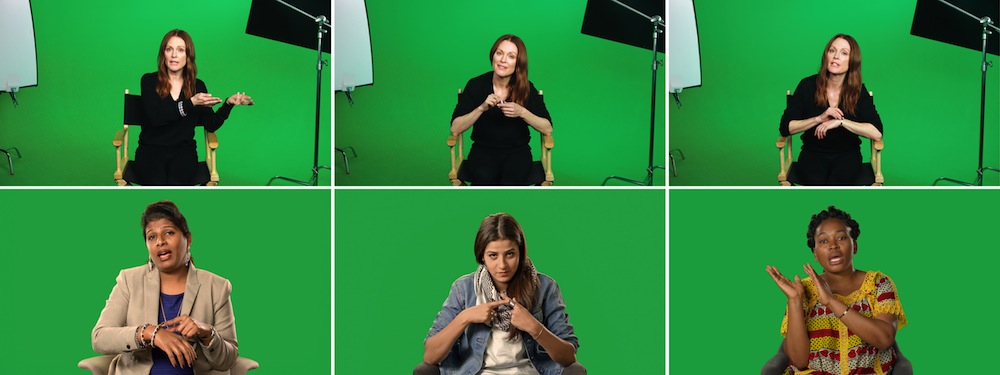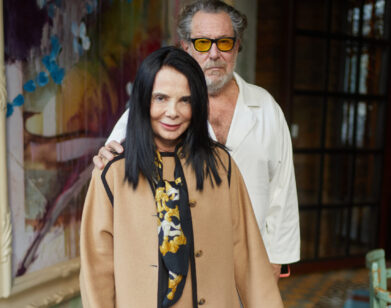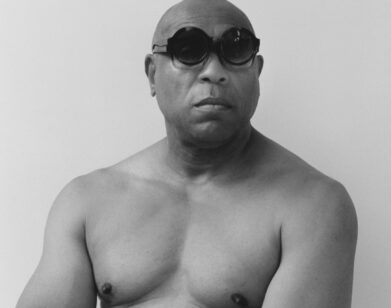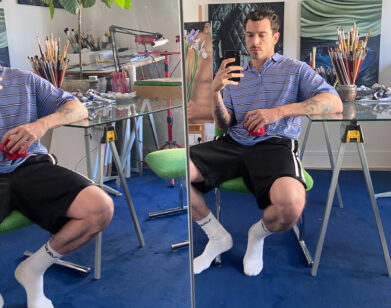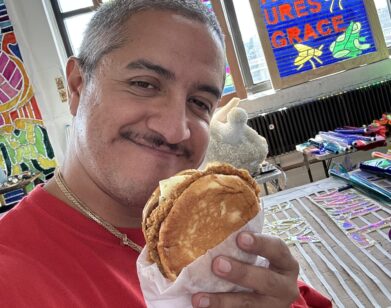Six Stories, Twice Retold
At the 57th Venice Biennale’s South African Pavilion, Candice Breitz offers a set of stories, ones we’re perhaps less inclined to listen to than we’d readily admit. The tales belong to six refugees whom Breitz interviewed on camera, and are delivered by the subjects themselves as well as through a retelling by Alec Baldwin and Julianne Moore. When viewing the work—which is collectively titled Love Story (2016)—in person, Baldwin and Moore get the first say. One walks into a video installation of a “Hollywood montage” in which the aforementioned actors portray each refugee, with no frills, no context provided, each story cut into pieces, jumping from one to another without transitions. In a second room, each interviewee tells her or his own story through separate video channels. “I wanted Alec and Julianne to almost bait you into a relationship with the stories,” says Breitz, “to invite you to consider the distance between the stories as Alec and Julianne tell them, and the remoteness of having to hear that same set of six stories now relayed to you at a slower pace, in less-perfect English, certainly less entertainingly.” Breitz points to what we’ll more eagerly absorb—stories told by familiar, famous, white, or privileged faces—and to the original individuals’ experiences.
Interview spoke to Breitz by phone after the Biennale began to discuss what, exactly, makes us listen. The artist hopes to bring the installation stateside in the future; it is also currently on view at KOW in Berlin and available in part online.
HALEY WEISS: This is a big question, but I’m curious if you think there are specific conditions or circumstances that predispose a viewer to being empathetic to what they are watching?
CANDICE BREITZ: I do, and I think that those conditions have to do with a certain exceptionalism which is characteristic of neo-liberalism, an exceptionalism that defines individuality according to a conventional set of qualities or achievements or appearances, which I think are embodied par excellence by Alec and Julianne, as two supremely visible, supremely celebrity, extraordinarily white, extraordinarily successful individuals who are really emblematic of a number of the values which pertain to exceptional individuality within cultures of privilege. What’s interesting about that way of thinking about the individual or measuring the individual is that that particular kind of individuality is not accessible by default, by most people, and there are all kinds of limiting factors whether it be race, the geography in which you were born, gender, or language. There are so many obstacles which prevent a majority of individuals from even coming anywhere near having access to the kind of exceptionalism, which in turn affords one or wins one a certain class or visibility or celebrity within our culture.
Why it is that identification or empathy is afforded only to those who have access to the same kinds of individuality that we already value? When you’re spending time with somebody in the work, spending time with the interviewees whose English is not as flowing, they’re not as self-consciously performative in the way that they offer you their stories. They hesitate, they repeat passages, they share details that a polished Hollywood script would have edited out. They never would have made it to the big screen and there’s a kind of grittiness. The ways in which they tell a story are very far removed from the qualities which we have socially been programed to accept as exceptional and as worthy of our attention and as worthy of our empathy. I suppose that what I am looking forward to understanding better as the work goes into the world is this question of, to what extent might it be possible to invite some questioning of those categories of individuality, who has access to them, who is able to perform them?
WEISS: The work certainly raises the question of what is the more effective way of telling these stories through mainstream media? I was struck in watching these interviews that part of what you’re doing is adding nuance to the “the refugee crisis,” which is sort of described in the media as this homogenous mass. I’d love to hear how you chose who would be represented in this and why a variety of experiences were important to you.
BREITZ: The question of individuation is very important to me. I was Berlin, like many, during the summer of 2015 when the so-called “refugee crisis” of displacement became very, very tangibility felt. One felt the arrival of new faces and new people and new languages, and anyone who had any kind of interest in what was going on was trying, in small or large ways, to engage or make sense of or help if possible in that very intense moment. What occurred to me was the way that the mainstream media was reporting, it’s almost obvious to say, on the crisis of displacement typically in very broad terms. There were all kinds of stories about 800 African refugees on a boat in the Mediterranean and how the Syrians were walking across Europe. There very rarely was one offered by mainstream media with the possibility of empathizing with an individual story or with an individual experience. Picking up on what we were saying before, there already lies a challenge or obstacle to empathy because it’s hard to empathize with a statistic or a figure or a completely unindividuated mass that is not rendered familiar to you. So one of the early impetuses to the work was a desire to individuate and to get at or to give a platform to the particularity or the richness of individual stories, and that meant at the beginning speaking to lots and lots of different people and spending long stretches of time getting to know people.
In terms of the selection, I certainly wanted to avoid localizing the refugee crisis, so I knew early on I didn’t want to shoot in one city or one country, but rather to think of the crisis of displacement as something which has a global scale to it, and it just so happens that the three countries that have been a home and which I move between—as a very privileged migrant—Germany, South Africa, and the U.S., are also, in their geographic contexts, major, major magnets for asylum seekers or for refugees. Of the six interviews, two were shot in Berlin, with a young Somalian man, [Farah Abdi Mohamed,] and then with Sarah [Ezzat Mardini], a Syrian. Two were shot in New York, with Luis [Ernesto] Nava [Molero], who is a Venezuelan, and Shabeena [Francis Saveri], who is a trans woman Mumbai. And the final two were shot in Cape Town, with José [Maria João], who is a former child solider, and with Mamy [Maloba Langa], who is from the Congo. What was important in terms of the selection of the stories was certainly a geographical range, which started to imply the scale of the crisis and to withdraw it from a very specific local context, and to try and connect the dots between all of these crises. Secondly I really wanted to have range of stories, which hinted at the vast variety of reasons that force people to leave everything behind. So in the six stories the reasons why the six interviewees felt that they had no choice but to leave are very different.
WEISS: Another question that came to mind while watching these videos is what makes someone’s story believable and who has the right to tell it? When they talk about doing their asylum interviews, they have to convince the person they’re speaking to that they are good people, that they are refugees. What makes a story believable, generally?
BREITZ: To some extent I wanted the interview format, which is kind of the core of the work, to mimic or to simulate this process of downloading one story, which is the asylum interview; each of [our] interviews lasted a full day, and it’s been very interesting to speak with the interviewees about their experience going through the asylum interview. We’ve spoken about the difference between the actual asylum interview and their interview with me, and you may have seen that there are points in the “Hollywood montage” and in the interview where they actually speak about their asylum interview. One of the things that interested me very much when I started to speak to and consider different people for the work was the way in which as someone is arriving, and this is not just for refugees but for any migrant, you’re constantly expected to rehearse your narrative, and narrate your story in order to narrate yourself into legitimacy. Of course when someone tells the same story over and over again, there’s a performative element to it, regardless of whether its the story of migration or a story that pertains to any aspect of life. You tell the same story again, you’ve thought about certain parts of the story, you know some generate positive responses, others bore people, and you mostly, I think, unconsciously try to craft your story, to tell your story in a way which is constructive. I think asylum seekers have a very complex relationship to the telling of the self, because they are constantly questioned.
WEISS: I wonder to what degree a story has to be entertaining to affect some sort of change. Because of the way mainstream media works, it does feel as though there is a great deal of desensitizing audiences to these experiences because there is so much to process. In what way do you think someone’s narrative has to be interesting in an entertaining sense to capture someone’s attention?
BREITZ: I think that we are unfortunately socialized to have shortened spans of attention, and the fact that most of us, certainly for younger generations this is true, our intake of information and news is typically through a finger, scrolling on some kind of mobile device. You scroll, and the amount of time you spend on each of the items that move across your screen is shorter and shorter. I like to think about the economy of our attention and the way we allocate attention; attention is more and more divided and separated across a variety of inputs and it means that stories which are complex and long, or stories that are accented, stories that are repetitive, meandering, stories which have a texture that is not packaged to meet our usual way of consuming information, stand a far lesser chance of winning our empathy. And even before that, harvesting our attention, forcing us to slow down and stop.
To some extent, I think that the work also tries to think about the way that information gets flattened by the format or the structure by which we receive it. So if you’re scrolling through your Facebook page or Instagram, whatever it is, and there’s a Trump story followed by a cute kitten story followed by a refugee crisis story followed by a Kim Kardashian story, somehow the pace with which we digest that information, the amount of attention that we direct towards it, is to some extent determined by how hard it is and how much effort and energy it takes to absorb what it is that we’re reading.
WEISS: Lastly, I’m interested to know what showing in the context of the Venice Biennale means to you as a representative of the South African Pavilion, what that carries for you.
BREITZ: To be honest, it is very significant for me. I’ve been fortunate to have a lot of support for my career, enough to be exhibited for the last 20 years internationally, but there is something different about being asked to represent your country. And it’s fraught. I have to say it was certainly not ambivalent news to hear, as I was being asked to represent South Africa as a white South African, at a point in our history where the urgent political transformation that we need has not yet happened. So I certainty felt quite strongly that whatever I showed would in some way need to have built into it a reflection on whiteness, on how much space whiteness takes up, and how much visibility is afforded to whiteness. That may not be obvious to everyone who views the piece, but on some level I think the piece asks questions about white-washing. To answer your question in a more general sense, we’re proud of our pavilion. [Artist Mohau Modisakeng and I] have a very modest budget and our space is a modest space, so we come to the task with relatively minimal resources. But I do think for the first time, and I’m not alone in this view, that South Africa has a pavilion which is meaningful. It is a pavilion which asks questions, not necessarily directly to the content of the South African experience, but also to the larger international dialogue that happens in Venice.
LOVE STORY IS ON VIEW AT THE SOUTH AFRICAN PAVILION AT THE VENICE BIENNALE THROUGH NOVEMBER 26, 2017. FOR MORE ON CANDICE BREITZ AND TO VIEW AN EXCERPT OF LOVE STORY, VISIT HER WEBSITE.

